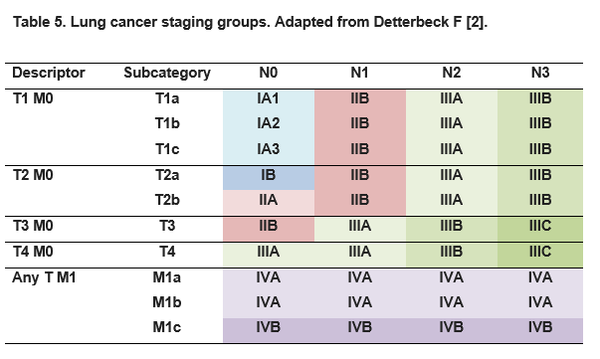-
Home
-
About JCTR
-
Gold Open Access
-
Issues
-
Editorial board
-
Author guidelines
-
Publication fees
-
Online first
-
Special issues
-
News
-
Publication ethics
-
Partners
-
Submit your manuscript
-
Submit your review report
-
Editorial Office
-

This work is licensed under a Creative Commons Attribution-NonCommercial 4.0 International License. ISSN print: 2382-6533 ISSN online: 2424-810X
Volume 6 Issue 4
New TNM staging in lung cancer (8th edition) and future perspectives
Matilla JM, Zabaleta M, Martínez-Téllez E, Abal J, Rodríguez-Fuster A, Hernández-Hernández J
Matilla et al. J Clin Transl Res 2020; 6(S4):4
Published online: September 2, 2020
Abstract
Background. Carrying out a correct anatomical classification of lung cancer is crucial to take clinical and therapeutic decisions in each patient.
Aim. TNM staging classification provides an accurate anatomical description about the extension of the disease, however, the anatomical burden of the disease is just one aspect that changes the prognosis.
Relevance for patients. TNM staging classification is a tool that predicts survival but we must to consider that TNM is just one of the factors that concerns the prognosis. The impact of a factor over the prognosis is complex due to: it depends on the specific environment, the treatment strategy among others; and our level of certainty makes difficult to include all the factors just in a group of stages. In some groups, there are difficulties to get large series, due to the low frequency of cases and the small number of events (metastasis, loco-regional recurrence). It doesn’t allow to obtaine evidence in a short period of time.. On the other hand, in the next years, new markers will be incorporated in the coming years, wich are going to be included in the new TNM classification. It could help to improve the classification giving more information about prognosis and risk of recurrence. All these aspects are being used by the International Association for the Study of Lung Cancer (IASLC) to develop a new prognosis model. This continues evolution of TNM system allows us to overcome the difficulties and build a flexible framework enough to continue improving the individual prognosis of the patients.

DOI: http://dx.doi.org/10.18053/jctres.06.2020S4.004
Author affiliation
1 Thoracic Surgery Department, University Hospital of Valladolid, Valladolid (Spain)
2 Pneumonology Department, Valdecilla University Hospital, Santander (Spain)
3 Thoracic Surgery Department, Santa Creu y Sant Pau Hospital, Barcelona (Spain)
4 Pneumonology Department, University Hospital of Orense, Orense (Spain)
5 Thoracic Surgery Department, Hospital del Mar, Parc de Salut Mar. Mar Institute of Medical Research. Barcelona (Spain)
6 Pneumonology Department, Complejo Asistencial de Ávila, Ávila (Spain)
*Corresponding autor
José-María Matilla
Department of Thoracic Surgery, University Clinic Hospital of Valladolid, Ramón y Cajal Avenue, 47005 Valladolid, Spain.
Email: jmatillag@saludcastillayleon.es
Handling editor:
Felipe Couñago
Oncologic Group for the Study of Lung Cancer, Spanish Radiation Oncology Society
Radiation Oncology Department, Hospital Universitario Quirónsalud Madrid; Hospital La Luz, Madrid; Universidad Europea de Madrid, Spain

